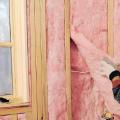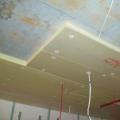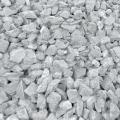Composition and proportions
Expanded clay concrete is a type of lightweight concrete, the main filler of which is expanded clay.
Obtained by special firing of clay, expanded clay has a porous structure. Thanks to this, concrete blocks are relatively light, but quite strong. They are mainly used for the construction of lightweight structures with a good margin of safety.
Composition and proportions
The main ingredients of expanded clay concrete: expanded clay (60%), cement (10%), quartz sand (30%). You will also need water to mix the solution. Sometimes plasticizers or special air-entraining additives are added, for example, saponified tree resin.
The fraction of expanded clay concrete is usually 5-10 mm. The smaller it is, the higher the strength of the blocks and the greater the weight. Therefore, this material has several classifications, for example, by strength or thermal conductivity.

It is best to purchase ready-made factory blocks. They are manufactured according to certain SNIPs and GOSTs, have strict proportions, the mixture itself is thoroughly mixed on special equipment, and then formed into blocks using the method of volumetric vibrocompression.
With your own hands
But you can make it yourself with your own hands, either individual blocks or a monolithic structure.
To do this, all parts of the expanded clay concrete ingredients must be loaded into a concrete mixer in the following order:
- water,
- expanded clay,
- cement,
- sand.
Typically, water is 8-10%, but the moisture content of the expanded clay itself should be taken into account. If it was outdoors or was previously wetted for better adhesion, then less water will be needed than for pellets stored in a dry room.
The amount of water should be taken seriously. If there is not enough of it, the expanded clay will absorb it, and the mixture itself will turn out dry and falling apart.
In this case, water is added little by little to the desired consistency. If there is too much of it, the solution will be very liquid. In this case, you need to let it sit for a bit. “Raw” expanded clay concrete should have a consistency such that it can be picked up by hand, and all granules should be covered with cement mortar.

In addition to a concrete mixer, you will need a vibrating machine.
A steel plate must be placed in the mold and filled with the mixture. Afterwards, the finished block is dried for 2-3 days. But ideally you should let it sit for about a week. If the blocks are dried outside in the heat, they must be sprayed with water to prevent them from drying out.
The steel plates are removed from the ready-dried block. They will acquire brand strength only after 30 days with regular moistening. A standard form requires 10-11 liters of mixture.
Classification
The main classification is by purpose.
There are types:
- structural - used for the construction of bridges, load-bearing structures of buildings, overpasses, etc.;
- structural and thermal insulation - mainly used in the construction of walls;
- thermal insulation - mainly used as insulation.
They are also distinguished by application (partition and wall), size and shape.
The latter can be solid (monolithic) or hollow, in which blind and through holes may be present.

Dimensions
Expanded clay concrete partition and wall blocks vary in size. But both are regulated by GOST 6133-99.
The wall dimensions are:
- 390x190x188 mm,
- 288x288x138 mm,
- 288x138x138 mm,
- 190x190x188 mm,
- 90x190x188 mm.
The full-bodied weight reaches 26 kg. Hollow (slotted) is a little lighter, about 17 kg.
Dimensions of the septum:
- 590x90x188 mm,
- 390x90x188 mm,
- 190x90x188 mm.
Its thickness is only 90 mm. Weight ranges from 7 to 14 kg (for hollow and full-bodied ones, respectively).
But almost any manufacturer can supply expanded clay blocks of non-standard sizes to order.

Characteristics
Expanded clay concrete blocks have a number of characteristics, the indicators of which can vary dramatically from each other depending on the type and size of the blocks, as well as the presence of certain additives in them:
- Strength. The lowest values are for thermal insulation blocks (from 5 to 25 kg/cm2). The highest are structural ones (from 100 to 500 kg/cm2). All intermediate indicators (from 25 to 100 kg/cm2) for structural insulation.
- Thermal conductivity. In terms of thermal conductivity, expanded clay concrete blocks can be compared to wood. And the less cement in the composition, the lower the thermal conductivity. But even heavy structural ones are much preferable to brick and ordinary concrete. If you use hollow blocks when building a residential building, it will be much warmer. Usually its indicator ranges from 0.14-0.66 W/m*K.
- Frost resistance. The lower the porosity of the material, the higher its value. So, for structural ones, frost resistance is up to 500 cycles, for structural and thermal insulation - 150, for thermal insulation - 15-50.
- Soundproofing. The higher the porosity of expanded clay concrete, the better the sound insulation. For example, blocks measuring 590x90x188 mm, folded into a partition, provide sound insulation of up to 45-50 dB.
- Vapor permeability. Thermal insulation materials have a higher vapor permeability (up to 9 mg/m*h*Pa) compared to structural ones (3 mg/m*h*Pa).
- Water absorption. For expanded clay blocks this value is 5-10% by weight, but can be reduced by adding plasticizers.
- Shrinkage. Gives the same shrinkage as heavy concrete, namely 0.3-0.5 mm/m.
- Maximum number of floors of buildings. It is preferable to use structural and thermal insulation blocks for low-rise buildings. But structural blocks allow you to build buildings of 10-12 floors.
About the features, characteristics and application of different types of expanded clay blocks, watch the following video from the channel ForumHouseTV. You will learn a lot of interesting things.
At home
Advantages of building houses from expanded clay blocks:
- As a material for individual construction Expanded clay blocks fit just perfectly. They retain heat perfectly, practically do not absorb moisture, which is why they do not freeze, perfectly protect against street noise, and are fire resistant. Due to its size, masonry is carried out much faster compared to brick. The only drawback is that the blocks do not always fit each other in size.
- The financial side of such construction is also pleasant. Firstly, the material itself is inexpensive. Secondly, it allows you to save on insulation, since it has low thermal conductivity. Thirdly, due to its light weight, it does not require a solid foundation, which can also save money. But expanded clay concrete is used only in the construction of walls. It is not suitable for pouring a base because it does not have sufficient strength for this.
- And due to almost insignificant shrinkage in the future you will not have to spend additional money on renovation work on the interior decoration of the rooms.
Thanks to all these advantages, houses made of expanded clay blocks are very popular in Europe. But in Russia they are no less in demand. This is a great budget option. An analogue could be a house made of foam blocks.

Any construction begins with the development of a house project and drawing up a work plan.
Consider the following nuances:
- Select the type of foundation. If a basement is not provided, then you can choose a strip foundation. As soon as the foundation gets stronger and shrinks, you can begin building the walls.
- Expanded clay concrete blocks are laid in the same way as bricks. But here it is important to maintain the same thickness of the mortar between the blocks. No differences, cracks or voids. All deficiencies are eliminated immediately as they arise.
- For comfortable living in a house, the thickness of the walls should be at least 40 cm. Otherwise, additional thermal insulation will be required. In addition, over time, the structure still slightly loses its ability to retain heat at the proper level, which will affect the increase in heating costs. Therefore, additional insulation never hurts, but it is better to place it outside.

Thermal insulation
You can increase thermal insulation in the following ways:
- It is possible to line expanded clay concrete blocks, but this method is expensive and is rarely used.
- A more affordable option is mineral wool. It is laid in 2 layers, with a layer of waterproofing between them. For vapor-permeable insulation, foil can be used.
- Fiberglass can also be used as insulation (both on the outside and on the inside). But to work with it you will need a respirator and protective gloves.
- If a choice is made in favor of polystyrene foam, then you should choose one with a higher vapor permeability rating. But it is important to remember that it is very popular with mice and other small rodents, and therefore must be walled up in concrete.
Facing
External cladding of expanded clay concrete walls can be made from:
- bricks,
- use facade plaster,
- thermal panels,
- cover with siding.

About the advantages of expanded clay blocks when building a house, watch the following video from the “Square Meter” channel.
Brands and prices
The strength of expanded clay blocks depends on their density, so the price of blocks with higher density is higher.
The higher the grade of the block, the higher its density:
- Grades 50-100 M are used mainly for thermal insulation purposes.
- For the construction of buildings, grade 150-200 M is used.
- Grades above 300 M are already used for the construction of various structures, for example, bridges and highways.
The price of expanded clay blocks varies depending on the size, shape (solid or hollow) and brand. On average across the regions, 1 wall block costs from 30 to 60 rubles, a partition block costs 20-40 rubles.
When calculating the cost of all materials, delivery costs must also be taken into account. In addition, all blocks are transported in special pallets. If the container is returnable, then a deposit is taken for it. If not, then the cost of one pallet can range from 100 to 300 rubles.
 Construction materials and list of works
Construction materials and list of works Proper insulation of a wooden ceiling in a private house
Proper insulation of a wooden ceiling in a private house What types of crushed stone are there?
What types of crushed stone are there?